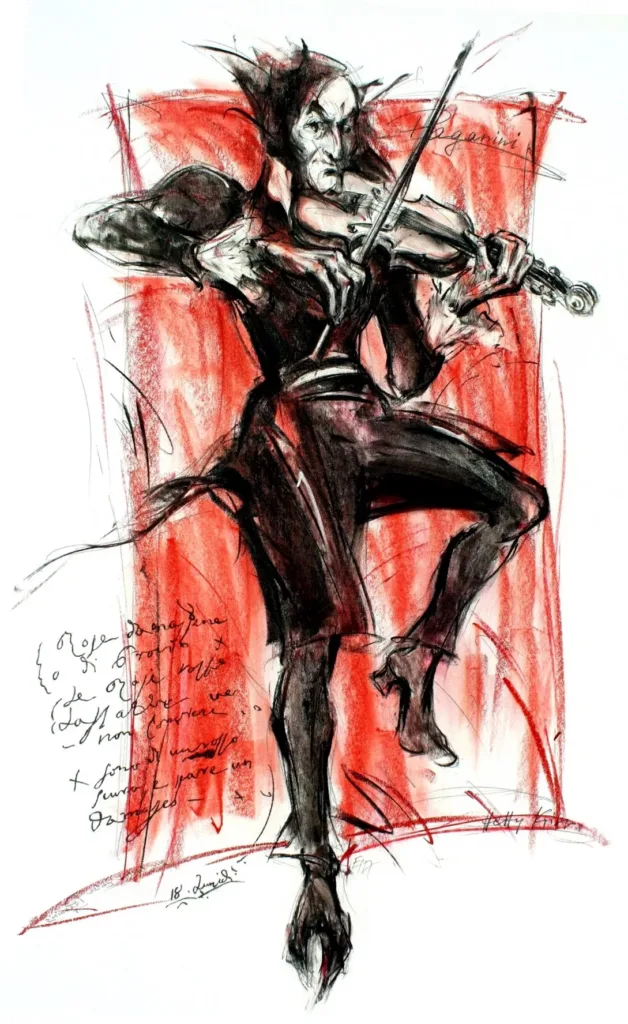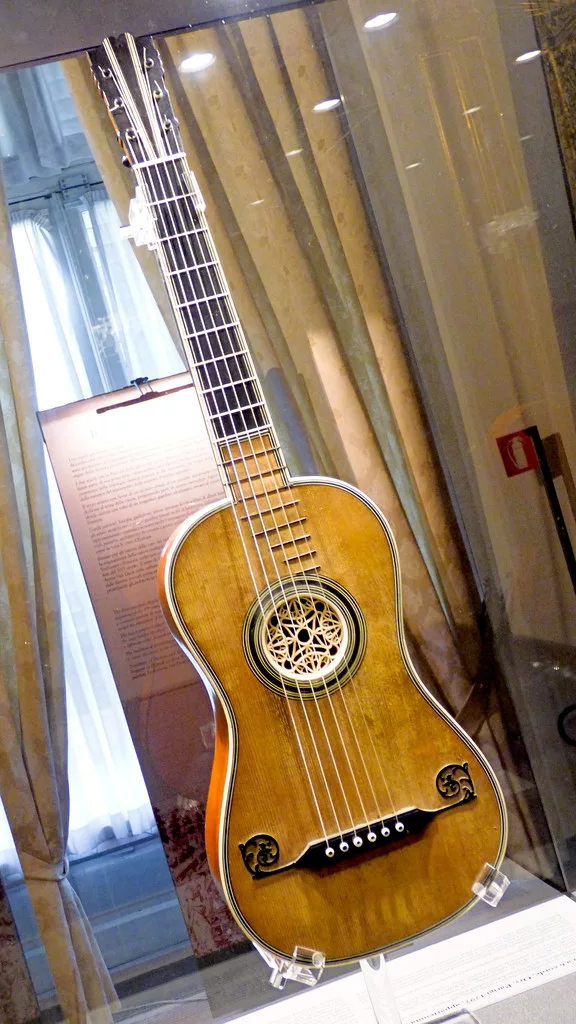In musical virtuosi, one name stands out as a beacon of unparalleled talent and innovation: Niccolò Paganini (1782 – 1840). As we delve into the enigmatic world of this master, an extraordinary texture of fascinating violin melodies and intricate classical guitar compositions unfolds before our eyes.
Imagine being transported to a bygone era in the early 19th century when Paganini’s mastery transcended simple notes on a staff, creating a fascinating narrative through strings that seemed to whisper the secrets of his soul. A musical pioneer, Paganini’s legacy fascinates and inspires generations of musicians and music lovers.
Through the annals of history, Paganini’s genius shines brightly like a radiant constellation in the night sky. His skill with the violin, similar to that of a sorcerer casting spells with every stroke of his bow, enchanted audiences and contemporaries alike. Yet hidden beneath the surface of his renowned violin virtuosity lies a treasure trove of lesser-known guitar compositions that reveal the depth and creativity of a multifaceted artist.
Join me on a journey through the labyrinthine passages of Paganini’s musical ingenuity as we uncover the interplay between his violin mastery and the hidden gems of his guitar repertoire, shedding light on the extraordinary legacy of this musical luminary.
Paganini: a musical virtuoso ahead of his time
Before delving into the enchanting world of Paganini’s violin mastery and guitar compositions, let us first explore the life and times of this extraordinary musician. Born in Genoa, Italy, on October 27, 1782, Niccolò Paganini showed prodigious talent from an early age. His father recognized his son’s potential and dedicated himself to cultivating Paganini’s musical abilities.
At the age of seven, Paganini began studying the violin under the guidance of his father. It quickly became apparent that he possessed an exceptional gift for the instrument. As he grew up, Paganini’s abilities continued to develop astonishingly. His technique was characterized by lightning-fast fingering, impeccable intonation, and a seemingly supernatural ability to execute complex passages efficiently.
Paganini’s performances were nothing short of legendary. The audience was captivated by his virtuosic performances and charming stage presence. He pushed the boundaries of what was thought possible with the violin, dazzling listeners with his innovative techniques and daring improvisations.

Unveiling the mystique of Paganini’s violin mastery
Paganini’s violin compositions are a testament to his unparalleled virtuosity and creativity. His works are characterized by intricate melodies, breathtaking technical challenges, and a deep emotional depth that resonates with listeners today.
One of Paganini’s most famous compositions is his 24 Caprices for solo violin. Each caprice showcases different technical aspects while displaying Paganini’s unique musical voice. These pieces are a valid showcase of his instrument mastery, from dazzling arpeggios to lightning-fast scales and double registers.
Another noteworthy work is Paganini’s Violin Concerto No. 1 in D major. This concert combines technical brilliance with lyrical beauty, allowing Paganini to demonstrate his virtuosity while captivating the audience with melodic richness.
The caprices, in particular, were composed to astonish the audience through rapid movements and the use of pizzicato and harmonics. The extraordinary skill with the left hand resulted from anatomy and grueling study.
Regarding the first factor, analysis of the cast of his hands post-mortem revealed that he “suffered” from what is usually called “arachnodactyly,” or fingers that are thin, long, and articulated like spider legs. Marfan syndrome, responsible for this condition, made his fingers extraordinarily agile and capable of covering prohibitive ranges for other violinists.
It must also be said that Paganini was also a skilled guitarist and practiced often on this instrument. The more comprehensive and much longer keyboard greatly complicated his technical “routine” (often consisting of scales of fifths or octaves), preparing his left hand for lightning-fast performances on his beloved Stradivari “Cannone” violin.
The enchanting world of Paganini’s violin compositions
While Paganini’s violin compositions are widely celebrated, his guitar compositions have often been overlooked. However, these hidden treasures reveal a different side of Paganini’s musical genius.
Paganini was a skilled guitarist and composed numerous works for the instrument. His guitar compositions show his ability to create intricate, catchy, technically challenging, and musically satisfying melodies.
One of his most famous guitar pieces is the Great Sonata in A major. This sonata is a tour de force of technical skill, featuring rapid arpeggios, complex chord progressions, and dazzling sequences that push the boundaries of what can be achieved on the guitar.
Exploring the intricate labyrinth of Paganini’s guitar repertoire.
Paganini’s guitar repertoire includes a wide range of styles and techniques. From delicate and reflective pieces to fiery and virtuosic compositions, his guitar works offer a glimpse into the depth and versatility of his musical imagination.
A notable example is Paganini’s Variations on“Nel cor più non mi sento.” This series of variations showcases Paganini’s ability to transform a simple melody into a dazzling display of technical wizardry. Each variation presents new challenges for the guitarist while maintaining a cohesive musical narrative.
Another notable composition is Paganini’s Sonata Concertata in A major for violin and guitar. This piece highlights the symbiotic relationship between the two instruments, with both parts complementing each other in a perfect interplay of melody and accompaniment.
The interplay between Paganini’s works for violin and guitar
Although Paganini’s violin and guitar compositions may seem distinct, they are closely related. His mastery of the violin has undoubtedly influenced his approach to guitar composition, resulting in works that push the boundaries of both instruments.
Paganini’s innovative techniques on the violin, such as left-hand pizzicato and harmonics, found their way into his compositions for guitar. These techniques added new dimensions to the guitar’s sound palette, expanding its expressive capabilities. Paganini made significant contributions to the Romantic guitar repertoire with his contemporaries Fernando Sor, Ferdinando Carulli, and Mauro Giuliani with a long series of doodles, sonatas, and various compositions.
In addition, Paganini’s understanding of violin virtuosity informed his approach to writing challenging passages for the guitar. His compositions for both instruments share a common thread of technical brilliance and musicality.
In 1992, the excellent guitar virtuoso Eliot Fisk transcribed and recorded the 24 caprices for violin, performing them with exceptional guitar mastery. The result is surprising, to say the least, and can only confirm Paganini’s desire to amaze his audience while also making a spectacle of himself. For the reader’s convenience, I have reproduced the Spotify playlist:
Paganini’s influence on classical music and beyond
Paganini’s impact on classical music cannot be overstated. His virtuosic performances and innovative compositions allowed future musicians to explore new possibilities on their respective instruments.
Its influence extended beyond the classical realm, inspiring composers of various genres to push the boundaries of their art. Paganini’s innovative techniques and daring improvisations laid the foundation for modern guitarists and violinists.

Paganini’s legacy: inspiring generations of musicians
Paganini’s musical legacy continues to inspire musicians around the world. His technical skill, musical innovation, and deep emotional expression are a constant source of inspiration for aspiring artists.
His compositions are studied by violinists and guitarists, serving as a benchmark for technical competence and musicality. The challenges presented in his works push musicians to hone their skills while also deepening the depths of interpretation.
Paganini’s lasting impact on the history of music
Paganini’s contributions to the world of music are immeasurable. His virtuosic violin performances and innovative compositions forever changed the landscape of classical music.
His influence can be felt in the works of composers who followed in his footsteps, such as Franz Liszt and Robert Schumann. Paganini’s legacy lives on through their compositions, inspired by his innovative approach to music-making.
Conclusion: the timeless legacy of Paganini’s musical genius
In conclusion, Niccolò Paganini was a musical virtuoso ahead of his time, a true star acclaimed by the masses whom he knew how to send into a proper frenzy. His mastery of the violin and guitar revolutionized how these instruments were played and composed.
Through his fascinating violin melodies and intricate guitar compositions, Paganini left an indelible mark on the history of music. His genius continues to captivate audiences and inspire musicians to this day, ensuring that his legacy will endure for generations.
If you like this post, you can always donate to support my activity! One coffee is enough!

